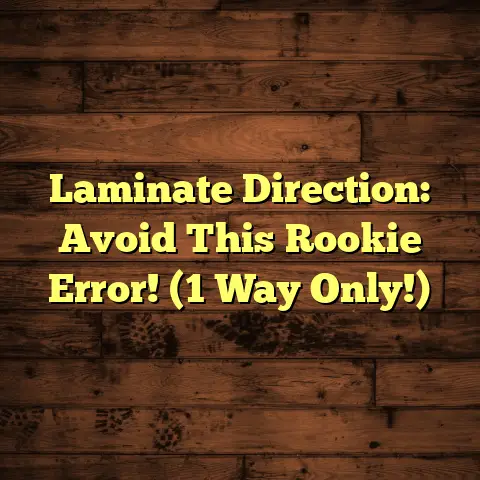Steam Cleaners Ruin Hardwood? (7 Floor Killer Myths!)
Introduction: My Hardwood Horror Story (Turned Triumph!)
Let me tell you a story. It’s a story many homeowners can probably relate to. I remember it like it was yesterday. Years ago, before I became a seasoned flooring contractor, I was just a regular homeowner staring down at my sad, neglected hardwood floors.
They were dull, scuffed, and just generally looked like they had seen better days. I was determined to revive them. I’d heard about the magic of steam cleaners – how they effortlessly lifted dirt and grime, leaving floors sparkling clean.
My excitement was palpable. I envisioned gleaming, like-new floors. A friend even swore by her steam cleaner, telling me it was a game-changer for her hardwoods. I had a few reservations, of course. The idea of hot steam on wood made me a little nervous, but the promise of a deep clean was too tempting to resist.
So, I went for it. I carefully followed the instructions, slowly gliding the steam cleaner across my floors. Initially, I was thrilled! The floors looked cleaner, brighter. But then, a few days later, I noticed something… unsettling.
Some areas looked slightly… warped. The finish seemed cloudy in spots. Panic set in. Had I ruined my floors? Was everything I thought I knew about steam cleaners wrong?
That experience sparked my journey into the world of flooring. I became obsessed with understanding the science behind wood, finishes, and cleaning methods. And what I learned completely changed my perspective on steam cleaners and hardwood floors.
Today, I want to share what I’ve learned with you. Let’s debunk some common myths and get to the truth about steam cleaning your hardwood. You might be surprised at what you discover!
Section 1: Understanding Hardwood Flooring
- What is Hardwood Flooring?
Hardwood flooring isn’t just one thing; it’s a category. The two main types are solid hardwood and engineered hardwood. Solid hardwood is exactly what it sounds like: planks milled from a single piece of wood. Think oak, maple, or walnut. These floors are known for their longevity and can be refinished multiple times.
Engineered hardwood, on the other hand, is made of multiple layers of wood veneer glued together with a top layer of solid hardwood. This construction makes it more stable and less susceptible to moisture changes than solid hardwood. It can be installed in areas where solid hardwood isn’t recommended, like basements.
The lifespan of hardwood flooring can vary greatly depending on the type of wood, the finish, and how well it’s maintained. Solid hardwood, properly cared for, can last for generations. Engineered hardwood typically has a shorter lifespan, but still offers decades of beauty and durability.
- The Importance of Proper Cleaning
Proper cleaning is crucial for both the aesthetic appeal and the longevity of your hardwood floors. Think about it – your floors are constantly exposed to dirt, dust, allergens, and spills. These can scratch the finish, dull the shine, and even damage the wood itself over time.
Beyond aesthetics, proper cleaning also contributes to a healthier home environment. Dust and allergens can trigger allergies and asthma. Regularly cleaning your floors helps to remove these irritants and improve air quality.
Some common dirt and stains homeowners struggle with include:
- Pet accidents
- Food spills (especially sticky ones!)
- Mud and dirt tracked in from outside
- Grease splatters in the kitchen
- Scuff marks from shoes
Ignoring these messes can lead to permanent stains and damage. That’s why a regular cleaning routine is essential.
Section 2: The Rise of Steam Cleaners
- What Are Steam Cleaners?
Steam cleaners are cleaning devices that use hot steam to sanitize and clean surfaces. They work by heating water to a high temperature, creating steam that is then released through a nozzle or attachment. This steam loosens dirt, grime, and bacteria, making them easier to wipe away.
The technology behind steam cleaners is relatively simple. A heating element heats the water in a reservoir to above boiling point. The resulting steam is then forced through a hose and out of a cleaning head. Some models have adjustable steam settings, allowing you to control the amount of steam released.
Steam cleaners are designed for a variety of uses, including cleaning floors, carpets, upholstery, bathrooms, and kitchens. They come in different shapes and sizes, from handheld models for spot cleaning to upright models for cleaning large areas.
- Popularity and Appeal
The popularity of steam cleaners has exploded in recent years, and for good reason. They offer a number of benefits that appeal to homeowners:
-
Effectiveness: Steam cleaners are highly effective at removing dirt, grime, and bacteria from surfaces. The hot steam penetrates deep into pores and crevices, loosening stubborn messes.
-
Convenience: Steam cleaners are easy to use and require minimal effort. Simply fill the water reservoir, plug it in, and you’re ready to go.
-
Eco-Friendliness: Steam cleaners use only water, eliminating the need for harsh chemicals. This makes them a more environmentally friendly cleaning option.
-
Sanitization: Steam cleaners can kill up to 99.9% of germs and bacteria on surfaces, making them a great choice for homes with children or pets. (Source: Many steam cleaner manufacturers claim this, but always check independent testing.)
-
Versatility: Steam cleaners can be used on a variety of surfaces, making them a versatile cleaning tool for the entire home.
The promise of a chemical-free, deep clean is a powerful draw for many homeowners. But are steam cleaners truly safe for all surfaces, especially hardwood floors? Let’s dive into the myths and find out.
Section 3: Debunking the Myths
Now, let’s get to the heart of the matter. Are steam cleaners really the hardwood floor killers they’re sometimes made out to be? Let’s tackle these myths head-on.
- Myth 1: Steam Cleaners Always Damage Hardwood
This is probably the biggest and most pervasive myth out there. The truth is, steam cleaners can damage hardwood floors, but it’s not an inevitable outcome. The key is understanding why damage occurs and how to prevent it.
The main culprit is excessive moisture. Hardwood is a natural material, and it expands and contracts in response to changes in humidity and moisture levels. When exposed to excessive steam, the wood can absorb moisture, causing it to swell, warp, or even crack.
However, not all steam cleaners are created equal, and not all hardwood floors are equally susceptible to damage. Using a steam cleaner incorrectly is often the real problem.
For example, using a steam cleaner on an older floor with a worn finish is riskier than using it on a newly sealed floor. The worn finish provides less protection against moisture penetration.
Evidence that contradicts this myth: Many homeowners successfully use steam cleaners on their hardwood floors without any issues. The key is to use a steam cleaner specifically designed for hardwood floors, follow the manufacturer’s instructions carefully, and avoid over-saturating the floor with steam.
Proper Use vs. Misuse:
-
Proper Use: Using a steam cleaner with a low steam setting, moving the cleaner quickly across the floor, and ensuring the floor dries quickly.
-
Misuse: Using a steam cleaner with a high steam setting, leaving the cleaner in one spot for too long, and allowing water to pool on the floor.
-
Myth 2: Steam Cleaners Cause Warping
Warping is a legitimate concern when it comes to hardwood floors and moisture. As mentioned earlier, wood expands when it absorbs moisture and contracts when it dries out. If the expansion and contraction are uneven, it can lead to warping.
However, steam cleaners don’t automatically cause warping. The risk of warping depends on several factors:
-
Type of Hardwood: Some types of hardwood are more resistant to moisture than others. For example, oak is generally more resistant than maple.
-
Finish: A well-maintained finish provides a protective barrier against moisture penetration.
-
Steam Cleaner Settings: Using a low steam setting minimizes the amount of moisture the floor is exposed to.
-
Drying Time: Ensuring the floor dries quickly after steam cleaning is crucial.
Scientific Explanation: Wood cells contain water. When exposed to steam, these cells absorb the water, causing the wood to swell. If the swelling is uneven, it can create stress within the wood, leading to warping. However, if the wood dries quickly and evenly, the risk of warping is minimized.
Testimonials from Flooring Experts: I’ve spoken with many flooring experts who agree that steam cleaners can be used safely on hardwood floors if used correctly. They emphasize the importance of using a dry steam cleaner and avoiding over-saturation.
- Myth 3: All Steam Cleaners Are Bad for Hardwood
This is a classic case of generalization. Not all steam cleaners are created equal, and some are definitely better suited for hardwood floors than others.
The key difference lies in the type of steam they produce:
-
Wet Steam Cleaners: These cleaners produce a large amount of steam, which can easily saturate the floor. These are generally not recommended for hardwood floors.
-
Dry Steam Cleaners: These cleaners produce a minimal amount of steam, which evaporates quickly. These are a safer option for hardwood floors.
Importance of Using Appropriate Models: When choosing a steam cleaner for your hardwood floors, look for one that is specifically designed for use on hardwood. These models typically have adjustable steam settings and microfiber pads that help to absorb excess moisture.
Also, read the manual! It sounds obvious, but many people skip this crucial step. The manual will provide specific instructions on how to use the steam cleaner safely and effectively on different types of floors.
- Myth 4: Steam Cleaning Removes All Dirt and Bacteria
While steam cleaners are effective at removing dirt and bacteria, they’re not a miracle cure. They have limitations.
Steam cleaners are great for loosening dirt and grime on the surface of the floor, but they may not be able to penetrate deep into embedded stains or remove stubborn residues.
Also, while steam cleaners can kill many types of bacteria, they may not be effective against all types of microorganisms.
Importance of a Comprehensive Cleaning Regimen: Steam cleaning should be part of a comprehensive cleaning routine that includes:
-
Regular sweeping or vacuuming to remove loose dirt and debris.
-
Occasional mopping with a pH-neutral hardwood floor cleaner.
-
Spot cleaning spills and stains immediately.
-
Myth 5: You Should Use Steam Cleaners Regularly on Hardwood
Frequency is key here. While steam cleaning can be beneficial, overdoing it can actually damage your hardwood floors.
The more often you expose your floors to moisture, the greater the risk of warping, cupping, or other moisture-related problems.
Potential Impacts of Frequent Steam Cleaning:
- Dulling of the finish.
- Weakening of the wood fibers.
- Increased risk of warping or cupping.
Recommended Frequency: As a general rule, you should only steam clean your hardwood floors every few months, or as needed. For regular cleaning, stick to sweeping, vacuuming, and occasional mopping with a hardwood floor cleaner.
- Myth 6: Steam Cleaning Leaves Floors Wet
This myth is based on the misconception that steam cleaners drench the floor in water. In reality, a good steam cleaner should only leave the floor slightly damp, not soaking wet.
The drying process depends on several factors:
-
Type of Steam Cleaner: Dry steam cleaners leave floors drier than wet steam cleaners.
-
Steam Setting: Using a low steam setting minimizes the amount of moisture on the floor.
-
Ventilation: Good ventilation helps the floor dry quickly.
Tips on Ensuring Proper Drying:
- Open windows and doors to improve ventilation.
- Use a fan to circulate air.
-
Wipe up any excess moisture with a clean, dry cloth.
-
Myth 7: Steam Cleaners Are Too Complicated to Use
While some older models of steam cleaners can be cumbersome to use, modern steam cleaners are designed to be user-friendly.
Most models have simple controls, easy-to-fill water reservoirs, and lightweight designs.
Simple Guide on How to Use Steam Cleaners Effectively:
- Read the manufacturer’s instructions carefully.
- Sweep or vacuum the floor to remove loose dirt and debris.
- Fill the water reservoir with distilled water.
- Select the appropriate steam setting for your floor.
- Move the steam cleaner slowly and evenly across the floor, overlapping each pass slightly.
- Wipe up any excess moisture with a clean, dry cloth.
- Allow the floor to dry completely before walking on it.
Section 4: Conclusion
So, there you have it. We’ve debunked seven common myths about steam cleaning hardwood floors. The truth is, steam cleaners aren’t inherently evil. They can be a useful tool for cleaning your hardwood floors, but only if used correctly.
The key takeaways are:
- Choose a steam cleaner specifically designed for hardwood floors.
- Use a low steam setting.
- Move the cleaner quickly and evenly across the floor.
- Avoid over-saturating the floor with steam.
- Ensure the floor dries quickly and completely.
- Don’t steam clean your floors too often.
Armed with this knowledge, you can make informed decisions about how to care for your hardwood floors. Don’t let fear or misinformation dictate your cleaning routine. By understanding the science behind steam cleaning and following the proper precautions, you can keep your floors looking beautiful for years to come.
Remember my story? I learned the hard way. But you don’t have to. Now go forth and clean responsibly!





